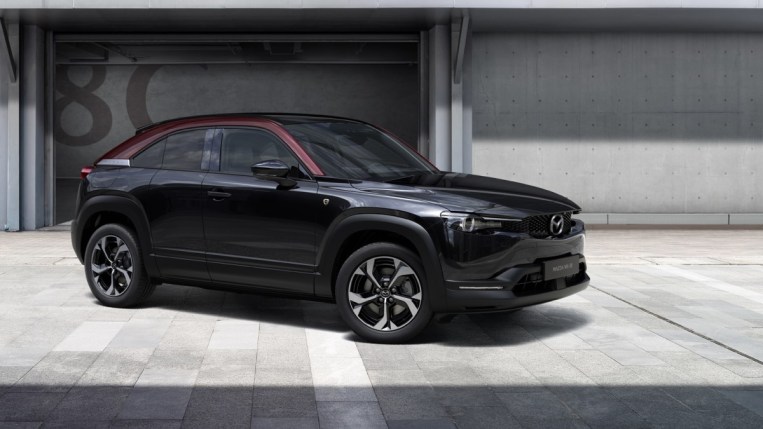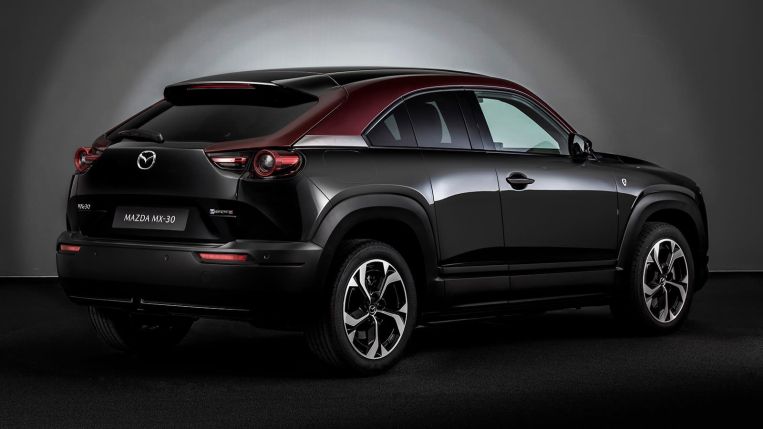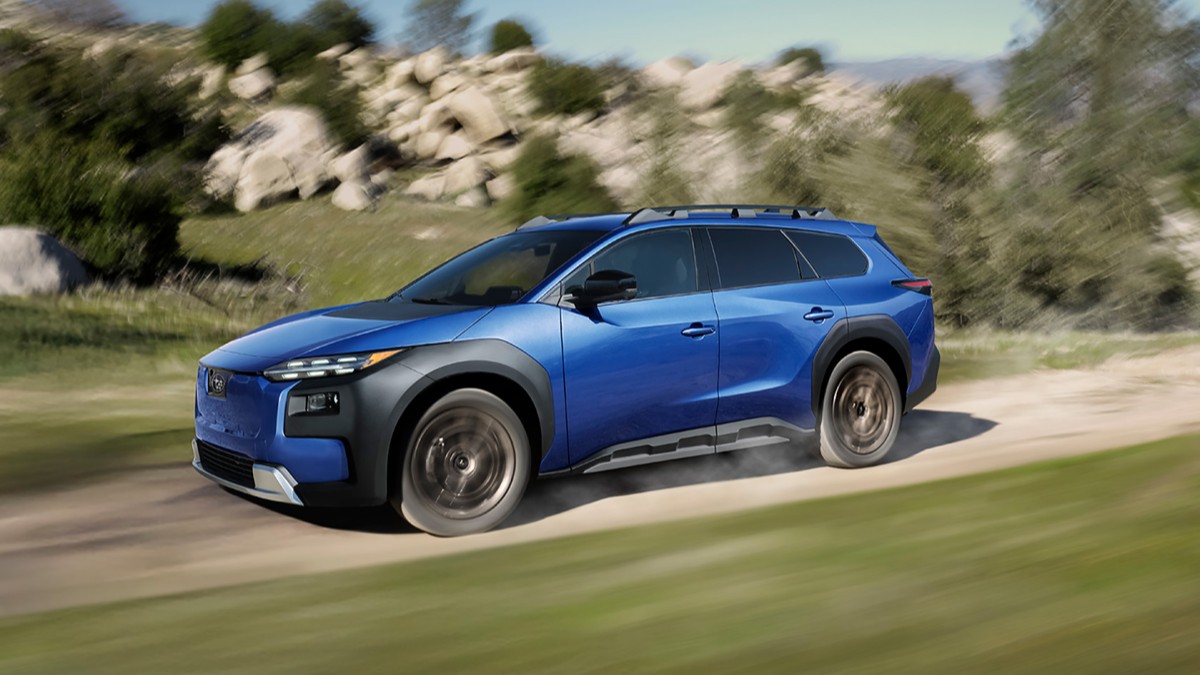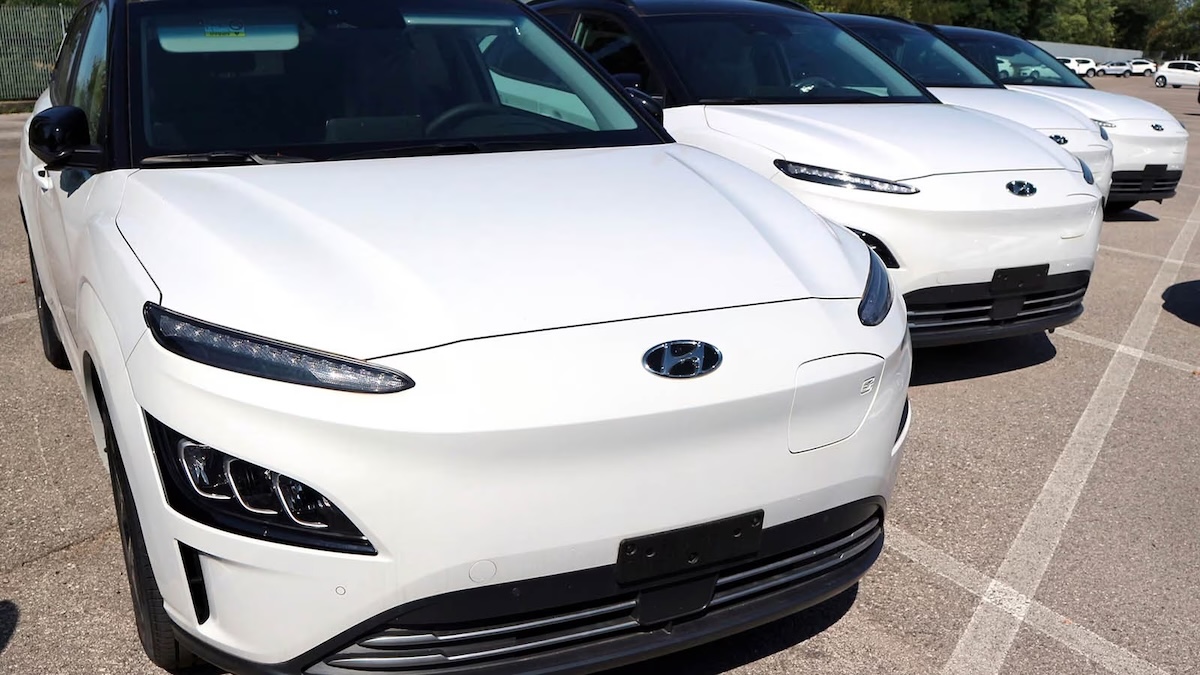
The Mazda MX-30 e-Skyactiv R-EV is quite handsome and could be practical for many buyers, but it combines so many strange traits that discussing it almost requires a glossary. And it will leave Mazda enthusiasts feeling teased and left hanging.
Everything about this car is unusual, so Mazda picked an unusual place to premiere it. The MX-30 e-Skyactiv R-EV appeared at this week’s Brussels Motor Show — not traditionally a major automotive event. It will go on sale first in Europe, but Mazda says it will reach the U.S. market in 2023, possibly as a 2024 model.
Pricing is unknown. The standard MX-30 EV starts at $34,110.
An Update to a Rare Vehicle
The Mazda MX-30 e-Skyactiv R-EV isn’t entirely new. But it is an update of a vehicle you’ve probably never seen.
The MX-30 is Mazda’s first electric vehicle (EV), introduced last year and sold only in California. It’s a sharp-looking compact SUV with a coupe-like profile, a contrast-color roof, and hidden rear doors. Built with sustainable cabin materials and the taut handling Mazda buyers love, it has a lot of virtues.
But it has the shortest range of any electric vehicle for sale in the United States — just 100 miles — drastically limiting its appeal.
That’s where the R in MX-30 e-Skyactiv R-EV comes in.
A Range Extender, Not a Normal PHEV
Range anxiety is the primary reason buyers shy away from the MX-30. So, Mazda built the MX-30 e-Skyactiv R-EV range extender.
What’s a range extender? It works much like a plug-in hybrid (PHEV). But not exactly.
A PHEV has both a gasoline engine and an electric drivetrain. It travels a certain distance under electric power alone (around 30-40 miles for most PHEVs on the market in 2023), then uses its gasoline engine to go further.
So, for many drivers, owning a PHEV is like owning an electric car for their commute and daily errands. But they can take road trips without stopping to charge, depending on gasoline to get them further.
The MX-30 e-Skyactiv R-EV works just like that, with one mechanical difference — its engine isn’t connected to its wheels in any way. The engine is essentially a generator, making the model something like a Tesla with a generator in the trunk.
It’s always using electric power to go anywhere, and owners will charge it from a wall outlet or charging station to power much of their driving. But when its battery is nearly depleted, the engine will turn on to recharge it.
If the technology sounds familiar, you’re probably remembering the Chevy Volt. The Volt, built from 2011 to 2019, mainstreamed the range extender concept.
The MX-30 e-Skyactiv R-EV, Mazda says, can travel 85 km (about 52 miles) on electric power alone before igniting the range extender.
A Rotary Engine, Almost Doing an Engine’s Job
The R in R-EV is the bit that got gearheads and historical Mazda fans excited.
For much of its history, Mazda was the only mainstream automaker to embrace an unusual type of engine. The rotary engine powered great Mazda sports cars from history, including the RX-7, which probably counts as Mazda’s major contribution to the automotive canon.
Most engines use a series of cylinders placed in one or two lines, each with its own piston. An inline 4-cylinder engine, for instance, has four cylinders in a line. A V8 has two rows of four, mounted in a V-shape.
Mazda’s Wankel engines (named after their inventor) use large oblong combustion chambers filled with an almost-triangular rotor that drives the combustion process by spinning. Rotary engines are known for smooth power output and punching above their weight, but they can be less fuel-efficient than traditional designs and run very hot, often requiring more frequent oil changes.
Rumors pop up every few years that Mazda will bring back the RX name or build a new rotary-powered car. Since the death of the RX-8 sports car over a decade ago, those rumors have always proven false.
Until now. Mazda is finally building a new rotary engine. But the faithful can’t get excited — it doesn’t even power the wheels.
Instead, the MX-30 e-Skyactiv R-EV gets a tiny rotary engine. According to InsideEVs, it’s a 0.83-liter model with a single rotor. It produces 74 horsepower, but the power is irrelevant because it doesn’t power the wheels.
The MX-30 e-Skyactiv R-EV gets 168 horsepower from its electric motor. That’s also the car’s total output figure since the Wankel is just along for the ride. It’s good for 0-60 mph, InsideEVs reports, in a leisurely 9.1 seconds.
All the MX-30’s Charms, Without the Range Anxiety
So, it’s weird; an automotive cryptid with the world’s tiniest obscure engine and a hybrid design like nothing else on the market. Why would anyone want it?
For all the same reasons they might want an MX-30 — just without the range limit. It’s still a handsome crossover, as the Edition R model Mazda showed off in Belgium looks exceptionally cool with its dark red roof over a black body.
It retains the MacPherson strut front suspension and torsion beam rear suspension that makes the MX-30 such a fun car to drive slowly. And the sustainable materials Mazda introduced for the all-electric version — like a cork-based trim and textiles made from recycled plastic — still look great.
And a few people will doubtlessly buy it for its oddity.
The MX-30 e-Skyactiv R-EV might catch on as a great-looking, practical little car for electric-only driving around town with infinite range thanks to its range-extending gasoline engine. Or it might stay as rare as Bigfoot sightings thanks to an overload of quirk and underwhelming power.










